Electric Vehicle Incidents
Operational Protocol
Scope
This Operational Guideline covers incidents involving electric vehicles (EVs) including vehicles with fully or partially electric power sources.
Fundamental Protocols underpin the actions of all NSW Rural Fire Service (RFS) members and must be adhered to at all times. They outline the Principles of being an RFS member and provide guidance on conduct to support the safety and wellbeing of members.
Protocol
- EVs include passenger vehicles, utilities, motorcycles, trucks, buses, and trams.
- EVs are currently categorised as: Light Electric Vehicle (LEV), Battery electric vehicles (BEV), Plug-In Hybrid Electric Vehicles (PHEV), Fuel cell electric vehicle (FCEV), Non-Plug-in Hybrid Electric Vehicle (HEV) or Mild Hybrid (HEV). See the table below for details relating to their different characteristics:
| EV Type | Characteristics |
| BEV – Battery Electric Vehicle |
Has no Internal Combustion Engine (ICE) and rely solely on a large lithium-ion battery for stored energy to fuel the vehicle’s electric motor. Charged from an external source and have other features for harvesting power while the vehicle is in motion, such as regenerative braking. Does not have an exhaust system and don’t require a front grill. Produces very little noise and can move without warning and without an occupant in the vehicle. |
| FCEV – Fuel Cell Electric Vehicle |
Powered by hydrogen and only emit warm air and water vapour, which may be present beneath the vehicle. Operate under a propulsion system like EVs. Have a small lithium-ion battery for storing electricity and fuelling the electric motors. Have other features for harvesting power while the vehicle is in motion such as regenerative braking. |
| HEV – Hybrid (Non-Plug-In) Electric Vehicle |
Self-charging hybrid vehicles that have an ICE with extra power supplied by electric motors, resulting in a smaller ICE. They have a lithium-ion battery large enough to power an electric motor for a short distance or longer distance at lower speeds. Cannot be connected to an external charger and instead harvest energy from regenerative braking and the ICE. |
| LEV – Light Electric Vehicle |
Light electric vehicles (LEVs) are defined as battery, fuel cell, or hybrid-powered 1, 2-or-3-wheel vehicles generally weighing less than 100 kg. Includes electric bicycles (e-bikes) scooters, skateboards, forklifts, and similar. Designed to travel short distances (approx. 10km) by a single occupant. Relies on rechargeable lithium-ion batteries/battery packs (attached to the frame) and charged from an external power supply (e.g., 240v wall outlet). Note- Electrically power-assisted and power-assisted pedal cycles are permitted for road use in NSW; however, E-scooters and E-skateboards can only be used on private property. |
| MHEV – Mild Hybrid Electric Vehicle |
Similar features to the Non-Plug-In HEV, however cannot be powered solely using electricity. The lithium-ion battery supplements power for the vehicle. Employ the smallest batteries of all EV’s and may be located in a variety of positions in a vehicle. |
| PHEV – Plug-In-Hybrid Electric Vehicle |
Contains an ICE and uses a combination of stored energy from a lithium-ion battery and the ICE to drive the vehicle. Battery can be charged from an external source and incorporates other features for harvesting power while the vehicle is in motion, such as regenerative braking. Batteries are often smaller with less range than a BEV. |
Personal Protective Clothing and Equipment
Always wear appropriate Personal Protective Clothing and Equipment (PPC/PPE) as determined by the dynamic risk assessment (DRA).
- Where available, wear full structural firefighting PPC and Self-Contained Breathing Apparatus (SCBA), wherever possible avoiding corrosive and/or caustic substances.
- Firefighters without structural PPC/PPE and SCBA, should:
- Wear full bush fire PPC including gloves, eye protection, and turned-up collars (flash hoods should be considered).
- Stay well clear of any smoke and vapours and remain 3m clear of the vehicle wherever possible.
- Request the dispatch of a crew with structural PPC/PPE and SCBA, from FireCom.
- When safe to do so, follow the ARSO (Approach, Rescue, Suppression, Overhaul) process outlined below for incidents involving EVs:
Approach
- Size-up /Identify – The Incident Controller (IC) will conduct a size-up the scene as per the RFS OPG - Approach and Size-Up, considering specific hazards (e.g. thermal runaway) relating to EV incidents.
- Look for EV signage (blue triangle) on number plate or other EV identifiers (i.e., QR code on windscreen, stickers, hybrid/electric labelling), or ask vehicle occupant if possible. See Appendix for more detail.
- Where possible, utilise the ANCAP Rescue app or manufacturer’s website for model-specific guidance/instructions.
- Immobilise and stabilise the vehicle – approach from an uphill, upwind position and at a 45-degree angle to the vehicle wheels, to avoid the areas of highest risk (side, front and rear).
- Turn off the ignition (in accordance with the manufacturers’ instructions). Identify the owner, take the proximity key (more than 5m from the vehicle) and shut down any apps capable of operating the vehicle remotely.
- Always assume the vehicle is powered, even if it is silent. Silent movement, or instant restart capability exists until the vehicle is fully disabled.
- Apply the park brake (prior to disabling the battery).
- Chock the vehicle’s wheels.
- Disconnect/isolate power – shut down or disconnect the vehicle if attached to a power source (e.g., pole-top or charging station) before any firefighting operations. An isolation switch should be installed within 2 metres of a unit.
- Contact the electrical network service provider to isolate an EV charging station if an emergency isolation switch cannot be identified.
- Confirm power isolation before approaching, applying water, or directing any firefighting streams onto the EV.
- Disable the vehicle – if safe to do so, manually disable the high voltage (HV) system and Supplementary Restraint System (SRS) features.
- This may involve removing the cut loop/plug, a pull fuse, or disconnecting the 12V battery by removing the negative lead. Note – disconnecting the 12V battery will disable some systems/functions. Allow up to 10 minutes for the HV system to discharge electrical energy.
- Avoid contact with any orange high voltage (HV) cabling connecting the battery to the motor. Do not cut, pierce, or touch damaged batteries.
Rescue
- If vehicle is, or might reasonably be occupied, ensure NSW Ambulance has been called. Initiate a primary search. Account for people. Protect search and rescue with a charged 38mm hose line with fog/spray nozzle.
- Protect and provide emergency care for trapped or injured persons. Unless no alternative is available (e.g., due to immediate threat from fire), leave removal of casualties to accredited rescue units.
- The batteries in an EV are heavy, making the vehicle more prone to rolling unexpectedly if on its side. If the vehicle is on its side on arrival to the incident, stabilise the vehicle to prevent it rolling any further.
- When using stabilisation equipment, be careful to avoid puncturing the battery casing, or touching the orange cabling or damaged HV components.
- Where possible never place stabilisation equipment against the battery casing.
- Be aware in the event of severe damage there is always potential for HV cabling or components to be exposed.
- Consider ventilating the vehicle to prevent a build-up of vapours or explosive gases. Exercise caution as an oxygen deficient cabin fire may cause rapid fire development when ventilated.
- Only appropriately qualified and experienced Road Crash Rescue (RCR) crew are to undertake rescue operations involving extrication of casualties.
- RCR operators should always visualise and expose the cutting area before starting, ensuring that there are no obstacles such as HV cabling or supplemental restraint system (SRS) components. Tunnelling through the boot, sill cuts and crushes may not be an option with EV, because of the location of HV cabling and batteries. Refer to the Emergency Rescue Card in the ANCAP Rescue App, or Emergency Response Guide found on the manufacturer’s website or via QR code on the vehicle.
Suppression
Where possible, determine the source/trigger for the fire. Use standard firefighting strategies and tactics (as per the RFS OPG - Vehicle Incidents) to extinguish fires in EVs where the car body is alight, but the battery does not appear to be involved.
Fire involving a battery
- If a battery is on fire and a direct attack is unsafe, it may be preferable to protect exposures and allow the fire to continue to burn until the battery is burned out if the situation allows.
- Locate the battery and orange cabling (see Appendix for more detail).
- Refer to the ANCAP App to determine the battery location based on vehicle make and model.
- If they’re involved or contactable, ask the owner where the battery is located.
- Check vehicle floor, under the centre console and rear seats; or boot space of the vehicle.
- Wear structural PPC/PPE and SCBA during suppression. If this equipment is not available, request attendance by a crew which has it. (Note – PPE and SCBA does not provide protection against skin absorption from vapours during thermal runaway).
- If safe to do so, attack the battery fire from uphill and upwind, to avoid toxic smoke and products of combustion. Be aware that projectiles may be released from the battery.
- Always approach at a 45-degree angle to the vehicle wheels, never from the front, rear, or sides of the vehicle depending on the configuration a battery pack in thermal runaway may vent or project jet like flames in these directions.
- Use freshwater (no saltwater) from a 38mm hose line with 700kpa at the nozzle . Do not use a live reel as it will not deliver sufficient volume. In addition, water runoff may contaminate the hose, which may need to be discarded at the scene.
- If reticulated water is not available on site, consider requesting additional pumpers, tankers, or bulk water supply.
- If the vehicle has not been immobilised, commence fire attack from 45º to the wheels, to avoid unexpected vehicle movement or high-pressure flames.
- Monitor the vehicle and battery for vapour release, smoke, or fire – be aware of unusual odours, and/or popping or hissing sounds that may indicate thermal runaway is occurring.
- Use a Thermal Imaging Camera (TIC) to identify areas of highest temperature within the battery. If a TIC is not available in the appliance on scene, ask FireCom to dispatch an appliance that carries one.
- Once the battery fire is extinguished, follow the procedures for smoke or vapour no fire, below.
- LEV batteries may be found in charging banks or attached to devices such as e-bikes. In exceptional cases, where a DRA has been conducted, it may be possible for firefighters to remove LEVs from premises and allow them to burn out in an open area clear of exposures.
Smoke or vapour - no fire
- If there is smoke or vapour but no fire, or a thermal runaway is suspected/occurring:
- Crews without structural PPC and SCBA must implement a 3 metre Exclusion Zone. Operate outside of the smoke or vapour.
- Protect exposures.
- Use a TIC to identify areas of highest temperature within the battery on the outer casing.
- Apply a constant stream of cooling water to that area of the battery casing for 15 minutes.
- After 15 minutes of cooling, stop and monitor the battery casing with a TIC for 15 minutes, to identify any temperature increase.
- Continue cooling and monitoring until ambient temperature is achieved.
- After ambient temperature is reached, monitor for an additional 60 minutes before handover.
Damaged battery
- In the event of a ruptured battery compartment, consider the risk and if required, request that FireCom contacts FRNSW for Hazardous Material (Hazmat) advice and support.
- Electrocution while fighting a fire in an EV is extremely unlikely, as HV energy stored in the battery is electrically isolated from the vehicle’s chassis, so does not seek a path to ground and will not travel up the hose stream. However, if the outer casing of a battery is damaged or compromised in some way, there is a DC electricity hazard with the risk of electrocution.
- In the case of a damaged battery, implement the available controls:
- Set up an Exclusion Zone around the hazard; and
- Communicate the hazard to those at the site.
Incidents involving a Vehicle Charging Station
- There are a wide variety of charging facilities for EVs, from large scale commercial units to domestic plug units. Brigades should prepare a Pre-Incident Plan (PIP ) for local charging stations to identify hazards and shut down processes.
- Locate/isolate power - shut down the charging station power source before any firefighting operations. An isolation switch should be installed within 2 metres of the unit.
- Contact the local electrical network service provider to isolate an EV charging station if an emergency isolation switch cannot be identified.
- Confirm power isolation before approaching, applying water, or directing any firefighting streams onto the EV.
- Note - EV incidents may involve non-compliant EV charging equipment.
- If the charging station or equipment is involved in the fire, treat the scene as a structure fire and take all normal precautions associated with electricity (as per the RFS OPG - Structural Fires).
- In the event of a collision involving a charging station, the same approach of shutting down power should be applied, if safe and appropriate to do so.
- Be aware of sprinkler run off if power to the charging station has not been isolated.
- If there are other EVs in the area, check for fire extension or battery heating even if they do not appear to be running (EVs may be in auto stop/ready mode and still on).
- Other EVs connected to the same or neighbouring charging equipment may be affected.
Overhaul
- Do not forcibly open the casing of a HV battery to access burning cells as this may expose firefighters to HV DC electricity and toxic chemicals.
- During all post-fire operations, continue to wear full structural firefighting PPC/PPE and SCBA, wherever possible avoiding corrosive and/or caustic substances. Firefighters without structural PPC/PPE and SCBA must stay well clear of any smoke and vapours, should remain 3m clear of the vehicle wherever possible.
- Incident closure messages to FireCom should note that the incident involved was an EV. Fires involving batteries are Notifiable to State Ops.
- Consider all hoses exposed to water run off as contaminated and discard, following decontamination processes.
- Consider water runoff, accounting for proximity to waterways or environmental assets. If appropriate, contact FRNSW (for Hazmat considerations) and/or the environmental protection authority (EPA) for support.
Decontamination
- RFS members who have been exposed to smoke or runoff from fire involving a battery shall not leave the incident without undergoing decontamination. This includes those controlling the decontamination process. Vehicles and equipment shall be subject to decontamination either at the incident (preferred) or on return to the Staging Area.
- A decontamination kit is to be requested from FireCom.
- Establish a decontamination wash down area per the instructions contained in the decontamination kit.
- PPC/PPE (disposable overalls, disposable gloves and P2 or higher-level mask) shall be worn at all times.
- All contaminated clothing shall be bagged and sealed before liaising with the RFS District Office who is responsible for laundering of PPC/PPE with designated service providers. See Appendix for further details .
- Sealed bag(s) shall only be transported outside of the passenger cabin.
- The laundering of contaminated clothing in homes or Stations is strictly prohibited.
- All waste material shall be bagged, sealed, and marked with RFS barrier tape.
- This shall be left at the site (in the vehicle) of contamination for disposal by the owner/occupier.
- A Report of Workplace Injury / Illness / Exposure Form is to be completed for all RFS personnel who attended the incident.
- Refer to Appendices for further detail relating to decontamination process.
Handover/Post Incident
- During handover to the owner or other responsible person (or NSW Police), ensure the following is communicated:
- Damaged EVs, PHEVs, and LEVs must be stored a minimum of 15 m from other exposures for up to 4 weeks post-extinguishment due to the risk of re-ignition (secondary ignition) of the battery, which could occur at any time until the battery is made safe by a qualified person. Consider applying adhesive “warning” tape, identifying ongoing risks.
- There is an electrocution risk from the HV DC in damaged batteries. A unique property of damaged HV batteries is the presence of trapped lethal levels of DC electricity known as stranded energy.
- There are toxic products of combustion of electrolytes on the surface of a battery compartment, and electrolytes can have acidic or basic corrosive properties.
- Following handover, the IC will complete the BIRS report, documenting the incident, and acknowledge that handover guidance was provided to the receiving party.
Special Considerations
Hazards and Precautions
- Hazards include those present at all incidents involving motor vehicles and working on roads, such as traffic, and movement of unstable vehicles. In addition, specific hazards may exist that are only present when an electric vehicle (EV) is involved. These may include:
- Electric Shock/Electrocution - from exposure to HV direct current (DC) electricity (noting HV cables will be Orange in colour).
- Voltage detectors currently in use do not detect DC electricity. HV stranded energy trapped in cells due to the circuit being damaged, can be up to 1000 volts. After shutting down the HV system, EVs equipped with an inverter/converter to drive the electric motors will have capacitors that may take up to 10 minutes to discharge stored electrical energy.
- Never cut or pierce a sealed battery product enclosure.
- Do not touch the service plug (which is directly connected to the HV battery).
- Respiratory illness - from exposure to toxic and flammable gases and vapours (e.g. from lithium-ion batteries) if inhaled or ingested.
- SCBA is to be worn whenever dealing with a battery fire; (if unavailable - firefighters must stay clear of smoke and vapour issuing from an EV).
- Burns – from exposure to Extreme Fire Behaviour (EFB), high-velocity flame from batteries, and corrosive vapours, gases, or liquids.
- Vapour cloud explosions (VCE) - resulting in EFB are possible in the presence of heat from the battery as an ignition source. A build-up of vapour clouds can result in an explosive hazard and lower visibility, (making vehicle identification difficult).
- Hydrogen - is a colourless, odourless, and tasteless gas and cannot be odourised like other flammable gases. It may produce fire that is difficult to detect as it burns with an invisible flame. Consider using a thermal imaging camera (TIC) or a long wooden object (such as rake hoe handle, which will become alight) to assess whether the gas is on fire.
- Impact injury - from unexpected vehicle movement or projectiles (cells may be released under pressure in some EVs). Remain clear of the vehicle where possible and avoid the front and rear until vehicle is disabled.
- Secondary ignition - may occur hours, days, and up to four weeks after the initial incident. Use Thermal Imaging Cameras (TICs) and cool battery casings to ambient temperature (this may take a considerable time and volume of water).
Thermal Runaway
- Thermal runaway is a chemical reaction where a cell fails inside a battery, releasing excessive heat, toxic gases, and flammable vapours. The heat may affect surrounding cells also sending them into thermal runaway. Thermal runaway may be triggered by impact damaging battery cells; overcharging; a mismatch between the charger and cell voltages; or fire heating cells and causing their structural integrity to fail.
- Indicators of thermal runaway in a battery are:
- Intense or uneven areas of heat on the battery surface. (Use of TIC to monitor temperature is required ).
- High velocity smoke (white to greyish in colour) or white coloured vapour emitting from the battery, battery casing, or underside of the vehicle.
- A loud hissing noise (like a gas leak), popping, or crackling sounds.
- Jet-like flames emitting from the underside of the vehicle or at the battery vents.
- Leaked electrolyte is colourless and characterised by a sweet odour.
- Cooling with water can potentially prevent and reduce thermal runaway. Water is the best extinguishing agent as foam does not assist in cooling and may inhibit use of a TIC to identify affected areas of the battery.
- A large and sustained supply of water may be required (at least 4000 litres ). The battery needs to be cooled with water and its temperature checked with a TIC. If its temperature is elevated above ambient temperature, continue to cool it and check its temperature every 15 minutes. When the battery is at ambient temperature, the battery needs to be monitored for 60 minutes, checking with a TIC to ensure that its temperature is stable.
Other Considerations
- Due to the potential for rapid escalation of fire at EV incidents, if the vehicle is located in an enclosed location such as a multi-storey or underground carpark:
- Consider if the fire size and behaviour allow for containment through the operation and boosting of any installed sprinkler systems, rather than close proximity firefighting.
- Be aware that sprinkler systems may not provide any assistance in cooling a vehicle battery as it may be shielded from sprinkler water spray.
- Consider the use of any air handling systems to control smoke and potentially toxic gases. Ensure that the exit point of these systems is not directed to a populated area. An exclusion zone taking into account the wind direction must be considered.
- If required, consider containing run-off using bunding, diversion, or on-site capture.
- Cells that are intact and have been exposed to abuse or show bulging or deformation should be considered dangerous, handled accordingly.
Related Information
- AFAC - Incidents Involving Electric Vehicles
- AFAC - Electric Vehicles (EV) and EV charging equipment in the built environment
- ANCAP Rescue App
- Electric Vehicle Incident and Emergency Response Training in FUEL
- 2021 Australian Emergency Response Guidebook
- RFS OPG - Hazmat Incidents
- RFS OPG - Vehicle Incidents
- RFS Report of Workplace Injury / Illness / Exposure Form
Appendix One - Procedural Checklist
- Have hazards and risks been evaluated as for any incident on roads or involving motor vehicles?
- Has a 360-degree size-up been conducted - including looking for badging or markers to indicate that the vehicle is electrically powered?
- If there is no smoke or evidence of fire, is the incident managed as for traditionally powered vehicles?
- If there is smoke but no fire, have you implemented a 3m exclusion zone?
- If there is fire, are firefighters wearing structural PPC and SCBA, or remaining uphill and upwind?
- If there is fire, and firefighters do not have structural PPE and SCBA, have you requested the attendance of a crew with this equipment from FireCom?
- Are you using a TIC to check that the battery casing remains around ambient temperature?
- If a TIC is not carried, have you requested the attendance of a crew with this equipment from FireCom?
- If there is fire, have you identified and accessed a large volume water supply (e.g. reticulated water, further tanker response, etc.).
- Have you briefed the person taking possession of the damaged vehicle (e.g. owner, tow operator, Police officer) regarding safety issues?
Appendix Two - Identifying Electric and Plug-In Hybrid Vehicles
- Electric or hybrid vehicles MUST display an ‘EV’ label and hydrogen vehicles must display an ‘H’ label. Indicators that a vehicle is an EV or PHEV include:
- EV signage on the vehicle number plate,
- QR codes on the vehicle’s windscreen, inside driver’s door pillar, fuel cap, under bonnet.
- Hybrid, Electric, or ‘zero emission’ badging or labelling.
- Questioning occupants about vehicle type.
- A blue hue around manufacturers branding which indicates environmentally friendly technology.
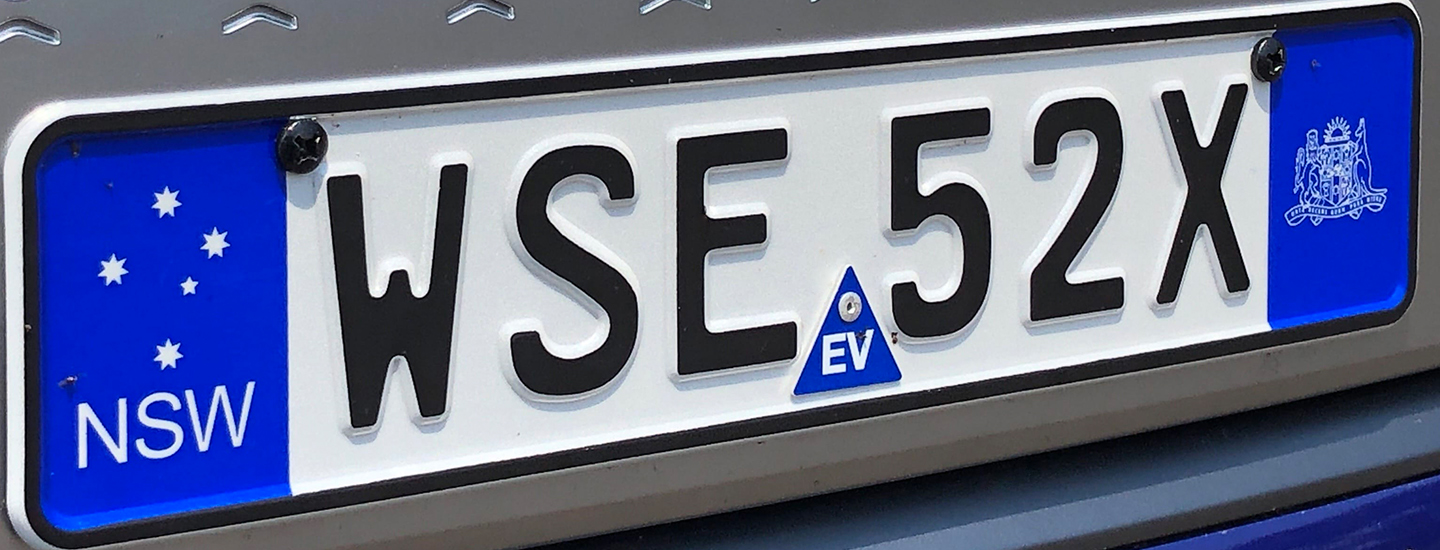
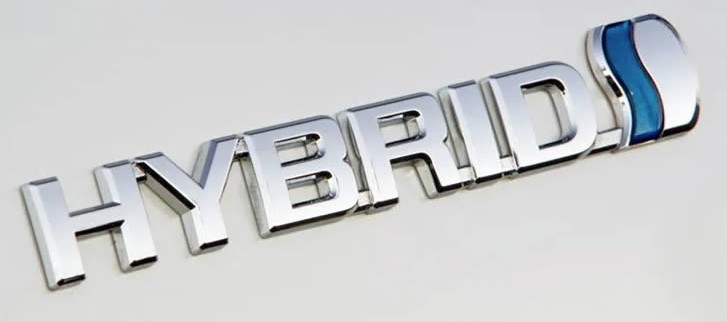


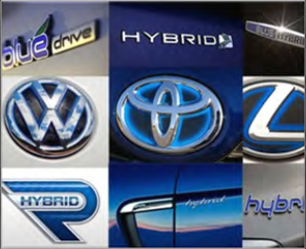
Appendix Three - Locate the Battery
- EV and PHEVs have high voltage cabling connecting the battery to the motor. Cabling colour is standardised as orange. However, the location of these cables varies between vehicle makes and models.
- The location of the battery varies:
- For EVs, the battery is usually under the floor pan of the vehicle, or runs under the centre console and rear seats.
- For PHEVs, the battery is usually in the boot space of the vehicle.
- For larger vehicles such as buses, trams, and trucks, the operator or owner of the vehicle may know the battery location.
- Manufacturers provide information for emergency workers on their websites and through the ANCAP Rescue App about the location of cables, location of batteries, as well as instructions for disabling the vehicle.
- There is further information about the management of battery-powered vehicles (with lithium-ion batteries) in the Australian Emergency Response Guidebook:
- UN: 3171
- Guide: 147
- Name of material: Battery-powered vehicle (with lithium-ion batteries)
Appendix Four - Decontamination Process
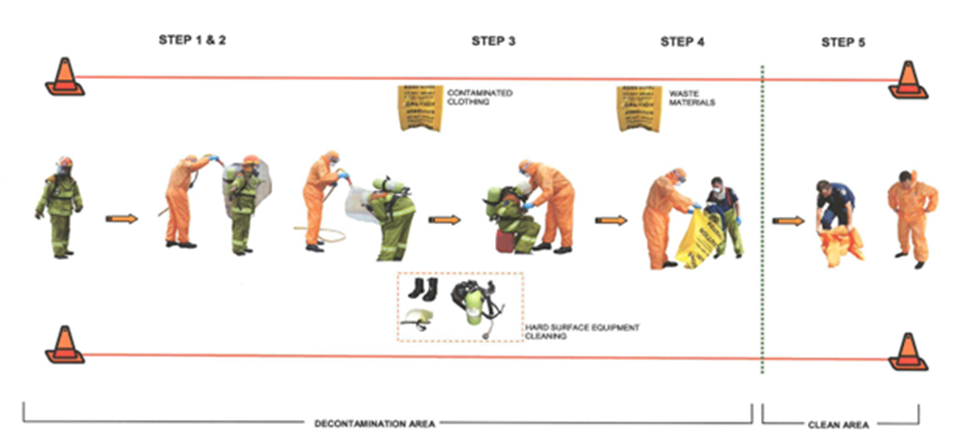
Wash Down Area
Establish a wash down area and set up equipment following instructions contained within the Decontamination Kit and as described in this Operational Protocol.
One (or more) member(s) should be designated to assist with the decontamination procedure.
Wash down area should be positioned external to the hot zone, on solid ground and upwind of the incident. Preference should be given to ground that slopes towards the area confirmed or suspected of being contaminated.
Firefighters undergoing decontamination must wear a P2 mask or SCBA until the decontamination process is complete.
Decontamination Process
- Wash down area should be positioned external to the hot zone, on solid ground and upwind of the incident. Preference should be given to ground that slopes towards the area confirmed or suspected of being contaminated.
- Firefighters undergoing decontamination must wear a P2 mask or SCBA until the decontamination process is complete.
Step 1
- Firefighter undergoing decontamination has outer clothing thoroughly wetted down by the application of a fine water spray.
- Firefighter removes helmet and goggles (if applicable).
Step 2
- Separate helmet neck flap, and place neck flap in the contaminated clothing bag provided.
- Helmet and goggles are set aside for the equipment cleaning procedure.
Step 3
- Gloves to be placed in Contaminated Waste bags with other material for disposal.
- Firefighter undergoing decontamination moves forward to disrobing area.
- Determine if boots are to be removed and set aside for equipment cleaning.
- If boots are to be re-worn, care must be exercised to ensure re-contamination does not occur.
- Protective clothing to be removed and placed in a contaminated clothing bag.
- Label contaminated clothing bags with PPC contents and quantities along with Brigade details.
Step 4
- Once soft garments are removed and placed in a contaminated clothing bag and other apparatus is set aside for equipment cleaning, fire fighter/s undergoing decontamination shall dry themselves as necessary with disposable towelling provided in the decontamination kit.
- All waste used in the decontamination procedure including disposable P2 masks and towelling must be placed in a separate contaminated waste materials bag provided in the decontamination kit.
Step 5
- Fire fighter/s undergoing decontamination moves forward to the clean area and dons disposable overalls. Decontamination assistants do not move into the clean area or further assist decontaminated fire fighter/s.
- Decontaminated fire fighter/s proceed away from the clean area.
- Upon completion of equipment decontamination, assistants should proceed to the designated clean area to remove disposable overalls, gloves and masks. Disposable materials must be placed in the contaminated waste bag.
Equipment
Equipment that requires decontamination includes, but is not limited to, goggles, torches, and SCBA sets. Additionally, any equipment that was utilised within the hot zone that is suspected or confirmed as being contaminated.
Step 1
- Equipment to be decontaminated should be located in the wet/disrobing section within the area used for personal decontamination.
Step 2
- Equipment to be thoroughly washed down with water. Post wash down, all surfaces to be wiped with towelling provided in the decontamination kit. Other suitable cloth or paper materials may be utilised if necessary.
- All materials utilised for the wipe down procedure are to be placed in the contaminated waste materials bag provided in the decontamination kit.
- Particular care must be taken in the cleaning process to ensure that all surfaces are wiped down. The material utilised for the wipe down procedure should be replaced at frequent intervals. Towelling or cloth must not be wrung out and reused.
Step 3
- Cleaned equipment should be re-stowed without delay. Take care to avoid mixing cleaned and uncleaned equipment.
Step 4
- On completion of equipment decontamination, assistants should proceed to the designated clean area to remove disposable overalls, gloves and mask. Disposable materials must be placed in contaminated waste bag.
Step 5
- Lay flat hose contaminated with asbestos fibres must be treated as hazardous waste and must be placed in the contaminated waste bag for disposal.
- Lay flat hose utilised at the incident but not suspected of being contaminated (i.e. relay or supply) should be cleaned following the equipment decontamination procedure. Vehicles parked within the hot zone are to be thoroughly hosed down before leaving the site.
Appendix Five - Decontamination Model
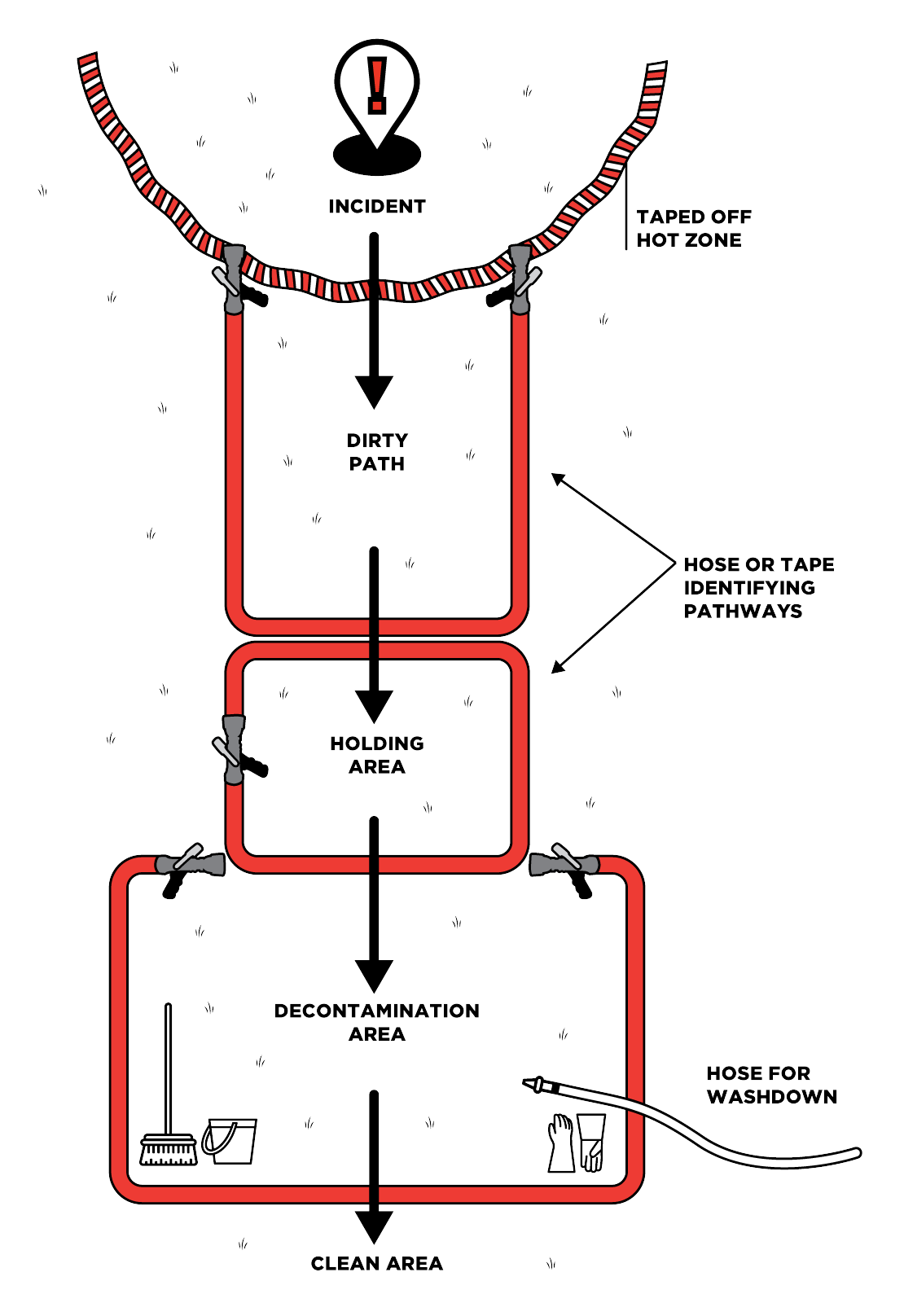
Appendix Six - Decontamination Zoning at an EV Incident
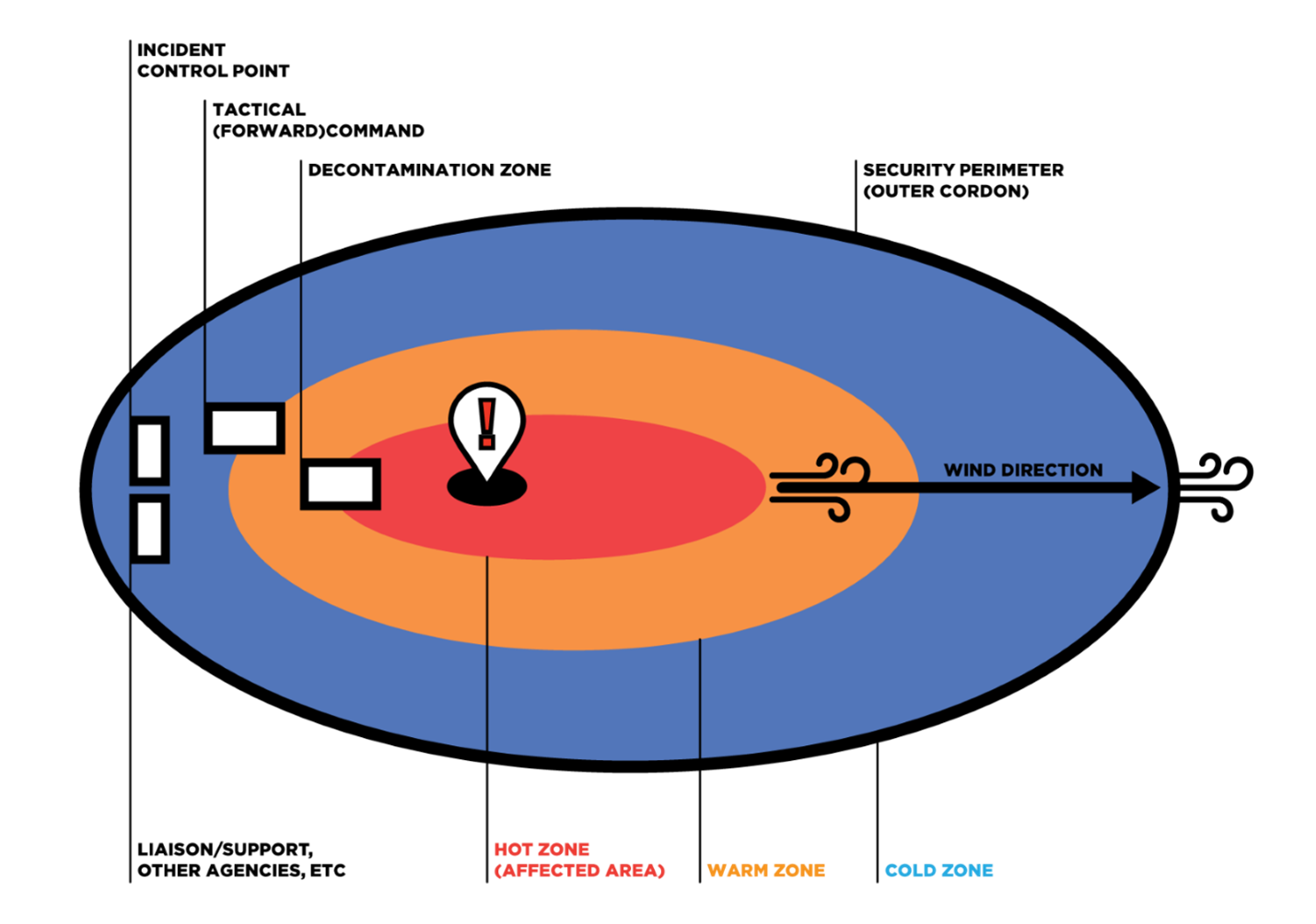
Appendix Seven - Laundering Contractors and Procurement Process
Laundering Procurement less than $3,000
- Raise a request for purchase in SAP Concur.
- When payment is required by the vendor payment via a corporate credit card is to be utilised.
- Reconciliation through SAP Concur is to use the Safety Unit Cost Centre of 30015. The Dry-Cleaning GL code is 512210.
- This transaction will escalate to the Manager Safety for approval
Laundering Procurement greater than $3,000.00
- Raise and submit a Purchase Requisition and attach the supplier quote in the SAP Portal. The Safety Unit Cost Centre of 30015 and Dry Cleaning GL code of 512210 is to be utilised.
- The Manager Safety will assess and approve if appropriate. A purchase order will be sent to the supplier via the SAP Portal.
- Once approved organise to have the-contaminated PPC/PPE transported for laundering.
- Once laundering is completed and items have been returned to the District complete a “Goods Receipt” in SAP.
Transportation of PPC/PPE to Laundering Suppliers
- Transportation costs will be charged to the district cost centre.
- Contact TOLL on 13 88 44 and quote account number S75512 (Note: this account specifically relates to the transport of Contaminated PPC/PPE and cannot be used for other purposes).
- If TOLL is not available, the district is to seek transport through local arrangements (i.e. staff or operational support brigade). Contaminated waste bags are not to be transported in the passenger compartment of vehicles.
- If TOLL is not available, the use of alternative Courier Services may be used by the district at their expense.
Content Owner:
Operational Improvement
Date Approved:
14 Sep 2024
Review Required:
14 Sep 2027
Version:
2.0
If you have any questions or feedback on Operational Doctrine, please email Ops.Performance@rfs.nsw.gov.au.



